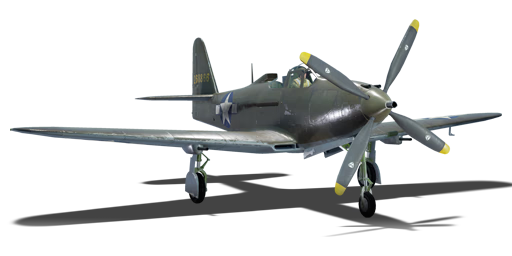



The P-63 Kingcobra was designed to improve on the shortcomings seen in the earlier P-39 Airacobra. Although the two planes seem similar, no parts on either aircraft are interchangeable, the P-63 was a new design. The first variant was the P-63A which started production in late 1942. The first deliveries began a year later, but the USAAF (US Army Air Force) rejected the Kingcobra. The Kingcobra would then find a home with the Soviet Union, which needed a competent fighter against the capable German fighters and pilots. The P-63A was virtually the same as the XP-63A but had more armour and fuel. The specific A-5 production block has a radio mast mounted on top of the fuselage and was later carried over to all variants. Not a single P-63 would ever serve in combat with the US; rather, almost every Kingcobra was sent to the Soviet Union and the few Kingcobras that did stay in the US were relegated to training use or target drones.
The P-63A-5 has been in the game since the start of the Open Beta Test prior to Update 1.27. Being an early variant of the Kingcobra family, the P-63A-5 misses out on various improvements like better engines and more ground ordnance. The P-63A-5 can only carry a single underslung 500 lb bomb, so ground attack is quite limited. The Kingcobra shines in air combat, particularly at low altitudes. Thanks to its Allison V-1710-93 engine, the A-5 can reach an impressive speed of 640 km/h (400 mph) and has an equally impressive structural limit of almost 900 km/h (562 mph). As for armament, the Kingcobra comes with four wing-mounted 12.7 mm machine guns and a single 37 mm cannon mounted through the propeller. With a full HE belt, the 37 mm cannon can easily take down an enemy fighter. However, continuous firing will quickly jam the gun and/or decrease accuracy. Also, the Kingcobra has five 10+ mm steel plates, many protecting the pilot and engine. Players should find the P-63A-5 Kingcobra to be a very capable fighter.
flaps
flaps
flaps
brake
| Belt | Belt filling | Armor penetration (mm) at a distance: | |||||
|---|---|---|---|---|---|---|---|
| 10 m | 100 m | 500 m | 1000 m | 1500 m | 2000 m | ||
| HEFI-T/AP-T | 37 | 34 | 25 | 18 | 12 | 9 | |
| HEFI-T/HEFI-T/AP-T | 37 | 34 | 25 | 18 | 12 | 9 | |
| AP-T | 37 | 34 | 25 | 18 | 12 | 9 | |
| HEFI-T | 4 | 4 | 3 | 3 | 3 | 3 | |
| Belt | Belt filling | Armor penetration (mm) at a distance: | |||||
|---|---|---|---|---|---|---|---|
| 10 m | 100 m | 500 m | 1000 m | 1500 m | 2000 m | ||
| T/Ball/Ball/I/AP-I | 28 | 26 | 18 | 11 | 7 | 4 | |
| AP-I/AP-I/AP-I/T/I | 28 | 26 | 18 | 11 | 7 | 4 | |
| T/AP/AP/AP/AP-I/I | 30 | 27 | 20 | 13 | 9 | 6 | |
| T/T/T/T/T/AP-I | 28 | 26 | 18 | 11 | 7 | 4 | |
| AP/AP-I/AP-I/I/I | 30 | 27 | 20 | 13 | 9 | 6 | |












Flight performance | |
|---|---|
Survivability |
|---|
Weaponry | |
|---|---|